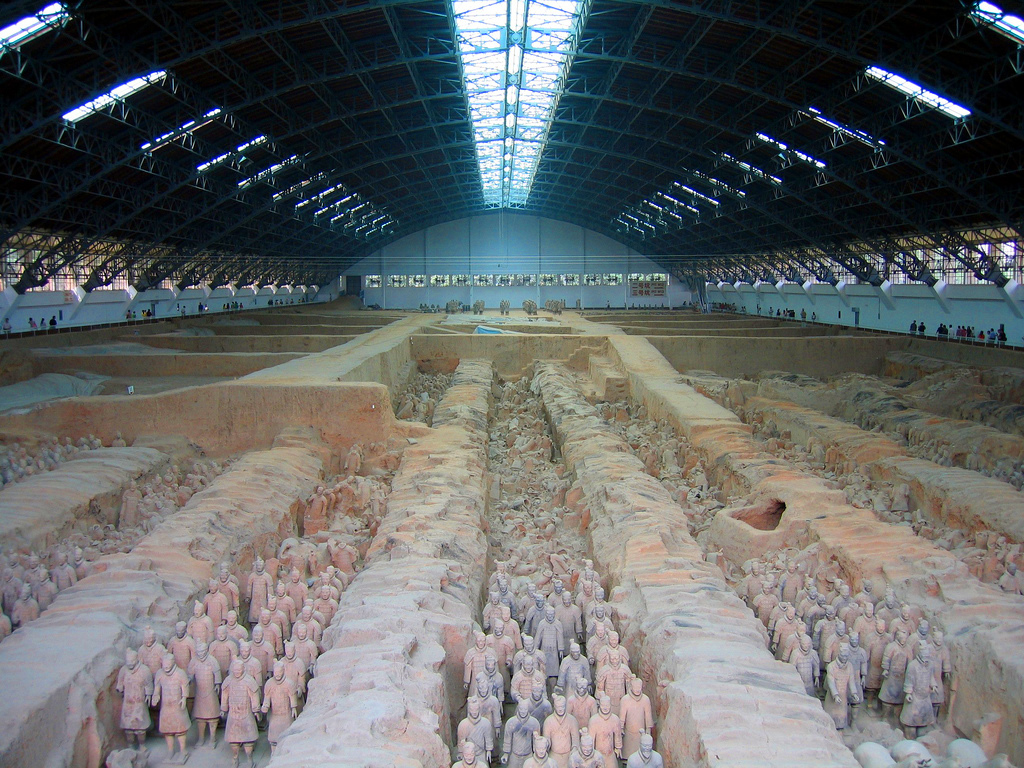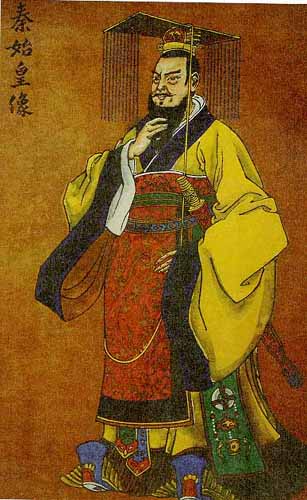Like the ancient Egyptian pharaohs who placed belongings, furniture, mummified animals, food, etc… in their pyramids for the afterlife, the terracotta army of the first Qin emperor, Shi huangdi, was to help him rule some ‘afterlife’ empire. Even in the United States, this notion of the protective nature of the terracotta army has been captured on film. One of these movies that I can recall was a Disney movie “Wendy Wu Homecoming Warrior” in which the main character has to fight and destroy an evil being that keeps returning, who can summon up these terracotta warriors.
This is a 10 minute clip from "Wendy Wu, Homecoming Warrior", but you only need to look at the first minute to see some of the heroes fighting representations of the terracotta warrior.
Discovery and Description
In 1974, a group of peasants, while attempting to dig a well in the Shaanxi province, founded this army. While for centuries, pieces of the terracotta fragments and figures had been dug up in the area, this new discovery had prompted archaeologists to explore further. While these archaeologists were investigating, they noted some 18th – 19th century graves, in which the diggers had come across some terracotta fragments but discarded them as worthless. There are four pits:
 |
| Terra Cotta Pit 1 |
Terra Cotta Pit 1 à contains 6,000 warriors and horses (only 1,000 have been unearthed), and covers an area of ~19,000 square feet. They are placed in well-organized battle array. Pit 1, which is the largest pit, is set so that it seems like they are ready and prepared for battle at any point.
Terra Cotta Pit 2 à ~7,100 square feet, and is shaped in an L-Shape formation. This pit, while with only about 1,300 warriors, is more elaborate and complete than any of the other pits.
Terra Cotta Pit 3 à ~600 square feet, and has been deemed the command center. It contains 68 warriors, but no commander-in-chief…so it is often speculated that it is the Emperor Shi Huangdi, himself that is supposed to represent this commander-in-chief.
Terra Cotta Pit 4 à empty of warriors, and sometimes called the accessory pits, which includes builder’s graveyards, slaughter pits, animals pits, etc…
Construction and About Emperor Shi Huangdi
Shi Huangdi was emperor of the State of Qin from 246 BC to 221 BC, and then Emperor of China from 221 BC to 210 BC. He began ruling at 13 and was able to unify China by 221 BC. The very fact that he was able to unify China and then ushering in almost 2,000 years of imperial rule makes him a very significant figure. According to historian Sima Qian, the construction of this necropolis would begin in 246 BC and involve around 700,000 workers (A LOT!) so basically he started this necropolis right when he became emperor of the State of Qin—almost seems like a testament to his confidence and thoughts about his abilities as a ruler. The terracotta warriors were manufactured in workshops by laborers and craftsmen and each were given different features and facial expression. The warriors are also life-size and vary in height, uniform, hairstyle in accordance to their rank.
 |
| Shi Huangdi |
I think it is pretty cool that there is such a large monument devoted to one man – I wouldn’t mind a necropolis for myself :D
These warriors look pretty amazing, is this a publicly accessible place?
ReplyDeleteHey Tina,
ReplyDeleteYour blog is full of useful information, but I'm curious as to where you're getting it all. Do you have a combine/paste approach or are you just synthesizing what you've read and giving us everything in your own words? Regardless, I think it would be great to include some sources so that if your readers want to do a little more research into something they're interested in, they can.
I also wanted to caution you against the bright red back ground. It took my internet browser a second to load everything so for a while I was just staring at the blaring red on the side. Just a thought.
Great job so far. I really like the font - changes things up a little bit.
- Britt
I liked reading about this. It is interesting to see how rulers in ancient cultures often dedicated immense manpower to construction of devices believed to help them in the afterlife. I think Shi Huangdi would be very proud of his legacy if he saw the fight scene in "Wendy Wu, Homecoming Warrior".
ReplyDeleteI look forward to your future posts.
Tina,
ReplyDeleteI visited Taipei a few years ago and had the chance to view a large display of these terra cotta warriors. I found them kind of unsettling. On the one hand, they speak to the immense power of the person who commissioned them all. On the other hand, well, he's as dead as anyone else now. I ended up seeing the figures as more depressing, as intimations of mortality, than anything else.
jh
Hi Tina,
ReplyDeleteAlthough I lived in China for 10 years, I've never visited the terra cotta pits before. I also don't know too much about these stone soldiers because I was at the time too young to know much Chinese history. Therefore, I really enjoyed reading this post and learning from it. Also, I like the overall idea behind your blog as it "reintroduces" me to Chinese history and culture.
-Peiying
Tina,
ReplyDeleteI have always been so intrigued by the Terra Cotta warriors and I really enjoyed reading this post. It's amazing just how many of them there are and how long and how much labor must have gone into their creation. I've enjoyed the posts that I've read on your blog because they are light and easy to read while introducing readers, like me, to various aspects of the Chinese culture that we might not be very familiar with. I look forward to reading more!
-Ellen
Tina,
ReplyDeleteInteresting post. It is amazing how much power these rulers had over the common people! Countless lives were spent building and serving rulers such as Shi Huangdi. While it is a fascinating part of history, I am certainly glad that I have the independence and freedom to not serve a dictator. Keep up the good work.
Sam
Interesting post about the Terra Cotta warriors. I have heard of them before, but I never truly appreciated the size and scope of the project.
ReplyDeleteI had no idea that the first pit was 19 thousand sq ft! That's a lot of warriors. I also never knew that each warrior had a unique face; the entire project must have taken quite a while to complete.